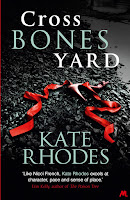by Kate Rhodes
Psychiatrist Alice Quentin, 32, appears to have it all: a growing practice at Guy’s Hospital; a surgeon boyfriend who is crazy about her; and an apartment in South London near the trendy shores of the Thames.
But her professional success is a thin shell hiding a childhood of abuse by an alcoholic father. All her education and training aren’t enough to free her from the anger and fears remaining from those experiences, nor to help her paranoid schizophrenic brother, Will, who lives in a ratty VW van in her parking space when he hasn’t taken to the road.
Author Kate Rhodes has written a compelling mystery with a likeable, flawed heroine at its heart. Fast-paced and suspenseful, readers will be guessing until the last startling minute who the murderer is. The plot unfolds against the backdrop of fashionable south London, just across the Thames from the Tower of London.
When the Metropolitan Police contact Guy’s Hospital to get a psychiatric evaluation of a soon-to-be-released prisoner, Alice is next on rotation to take it. The prisoner is Morris Cley, an associate of notorious serial killers Ray and Marie Benson. The Bensons ran a hostel of Southwark Bridge. They selected their victims from guests at the hostel, locking them up for weeks, starving them, raping them and carving dozens of crosses on their bodies before dumping or burying them. One victim survived; most died; and five suspected victims have never been found.
Not long after evaluating Cley, Alice finds a girl’s body, swaddled in black cloth and dumped in Crossbones Yard, an unhallowed burial ground for prostitutes used for centuries and now abandoned. Her throat has been cut and crosses carved on her arms, legs and torso.
Detective Chief Inspector (DCI) Don Burns tells Alice the murder resembles the ones committed by the Bensons in every way — including elements that the police never released to the public. Ray Benson hung himself in prison and Marie Benson, ill and blind, is still in prison. The murderer has to have been someone who helped or was close to the Bensons.
Alice finds herself in the middle of a murder investigation that seems increasingly personal, as Cley, her obsessive boyfriend and her brother all come under scrutiny by Burns and his deputy, Detective Sergeant Ben Alvarez.
This is the first of a series of mysteries featuring Alice Quentin:
- A Killing of Angels: Alice is brought in as a consultant to profile the murderer of wealthy, well-liked executive of the Angel Bank. Just before he was pushed under a subway, the murder put white feathers and a card featuring an angel in his pocket. This turns out to be the first of a series of murders focusing on executives working for the corrupt bank.
- The Winter Foundlings: Alice takes a break from South London to study treatment methods at Northwood High Security Hospital. One of its famous inmates is the silent Louis Kinsella, Britain’s most prolific child killer. When a young girl is found dead, dressed in white on steps of the Foundling Museum in London, there are clear connections to Kinsella’s work. DCI Burns asks for Alice’s help in reaching out to Kinsella for insights about who the killer could be.
- The Girl in the River: Alice is asked to reexamine the attempted drowning of Jude Shelley, daughter of a prominent cabinet minister. Although the Shelley family asked her to take another look at the case, Alice is convinced that the family is hiding something. Others will die if the Shelleys don’t talk.
- Blood Symmetry, due to be released this month. Alice is asked to work with a traumatized, abducted child, Mickey Riordan, to see what information he can provide to help the police find his mother Clare. Clare and Mickey were abducted together from Clapham Common. Hours later Mickey was found wandering disoriented. The police have been unable to find Clare.
Individually, these books are quick, entertaining reads. As a series, however, they don’t hold together credibly. The first two books seem to be richly detailed variations of the same plot template. Given that Alice had a general psychiatric practice when the series opened, I can’t help asking why the Met keeps returning to consult with a woman who doesn’t appear to have any credentials in criminal psychopathology.
This is partly a problem created by readers who want more of interesting characters and situations and by publishers who want a hooked audience. Unless the protagonist is in law enforcement, social work or private investigation, it doesn’t really make sense they would have one high-profile, high-drama serial killing after another to unravel.
Alice is a complex character with true potential for growth over the course of the series as she deals with trust and commitment issues. Unfortunately, for the most part, author Kate Rhodes doesn’t deliver on that potential.
Toward the end of A Killing of Angels and in The Winter Foundlings, Rhodes works to develop a relationship between Burns and Alice. Burns is an overweight survivor of a heart attack struggling to keep a dying marriage afloat for the sake of his sons. As the series unfolds, he loses weight, gets in shape, leaves his wife, makes another attempt to stay together for the kids and then decides that ending the marriage is the best decision. His arc is interesting and credible.
On the other hand, Alice doesn’t change: in The Winter Foundlings, she leaps into bed with a virtual stranger who tells her he doesn’t want a commitment. Despite the fact the Met repeatedly comes back to her to profile criminals, she seems unable to profile the men who want to become involved with her.
She insists on staying in a depressing, isolated cottage despite evidence that someone is watching her and the fact that the murderer dumps a body in the forest nearby. Through most of the book, she persists in believing a piece of gossip that suggests Burns is having an affair with his deputy, something even an inexperienced psychiatrist would have advised her to check out.
Reading the books in order is helpful to learn Alice’s background and to follow Burns’ changes. Since Alice isn’t evolving or revealing much of herself to her fellow characters, it would be easy to reach each book as a standalone.




